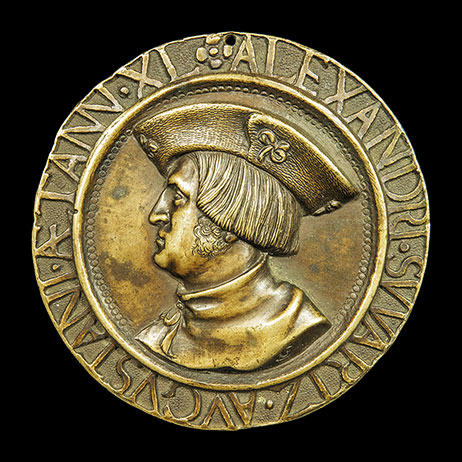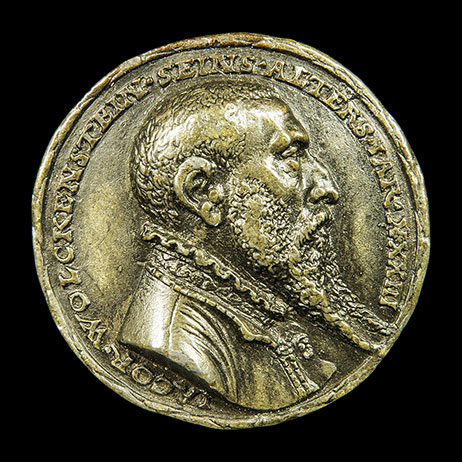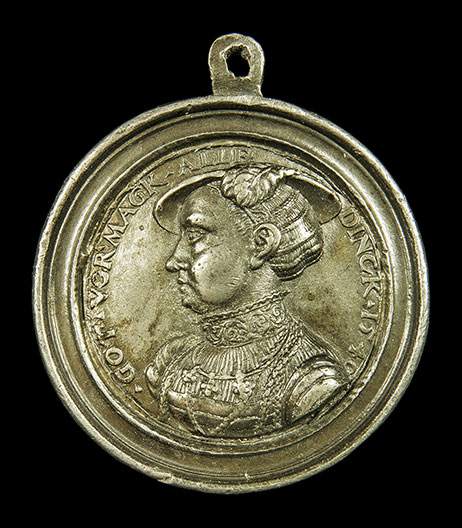Three German Renaissance Medals
These three cast medals are my first foray into the field of German Renaissance medals, previously having been focused only on Italian and French medals. Coincidentally, the three artists to which these medals are attributed are also three of the more significant German medalists of the sixteenth century.
.
Alexander Schwarz
Hans Schwarz, 1518.

Bronze, 68.9 mm Ø, 85.2 g
Obverse: Obverse: Bust of Alexander Schwarz facing left, wearing hat and cloak; incuse monogram (?) on truncation. Around, ALEXANDRI · SVVARTZ · AVGVSTANI · ÆT · ANN · XL (Alexander Schwarz of Augsburg, Aged 40 Years).
Habich identifies Alexander Schwarz (1478 - c. 1532) as a relative of the medalist, and possibly the same Alexander present in a Schwarz family portrait by Hans Holbein the Elder. An Alexander Schwarz identified as a builder is noted to have been in Augsburg in 1509, in Nuremberg ten years later, to have received permission from the Augsburg Council to live outside the city ten years after that, and to have received honors in 1538 for his works. However, Habich also notes that a record from 1532 indicates that Schwarz had died; he suggests in this case that the builder of the same name was likely his son.
There have been different interpretations as to the "monogram" on the truncation of the bust, with it variously being seen as GJ or VC. Early theories were that it was the signature of the artist, though the existence of the portrait sketch by Hans Schwarz for this medal confirms the attribution to him. Habich posited the signature as that of a later copyist; however, Kastenholtz notes that in the examples containing this mark, there is nothing artistic or stylistic of them being copies of an original. Rather, he suggests that, since the mark is unclear, it may simply be a mark on the model which was then reproduced on the medals made from it.
References: Habich 1929-34, no. 124; Kastenholz 2006, no. 25
.
Jakob Wolckenstein
Matthes Gebel, 1542.

Lead, 36.1 mm Ø, 18.6 g
Obverse: Bust of Jakob Wolckenstein facing right with long beard ending in two peaks. Around, IACOR · WOLCKENSTEIN · SEINS · ALTERS · IAR · XXXIII (Jakob of the Wolckenstein House, 33 Years Old).
Jakob Wolckenstein, of Nuremberg, was born c. 1509 to Sebald and Katharina. Habich notes that his grandparents, Veit and Margaretha, had owned a house in Nuremberg, and that the family's lineage is said to have come from Leipzig or Meissen.
This medal is known paired with a reverse which is dated 1542. However, Habich notes that the reverse is by a different hand, or possibly from a different source altogether.
Published: This piece cited in Habich 1929-34, p. 169 no. 1212.
Provenance: Ex Hermann Vogel collection.
References: Habich 1929-34, no. 1212
.
Emilie of Saxony
Christoph Weiditz, 1540.

Lead, 45.0 mm Ø (including frame), 27.8 g
Obverse: Bust of Emilie of Saxony facing left, wearing embroidered chemise and low hat with feather. Around, · GOT · VORMAGK · ALLE / DINCK · 1540 (God Is Before All Things, 1540).
Emilie of Saxony (1516-1591), Margravine of Brandenburg-Ansbach, was the daughter of Heinrich IV, Duke of Saxony. She married Georg the Pious (b. 1484), the future Margrave of Brandenburg-Ansback, in 1533. After two previous marriages had produced no male heir, Georg Friedrich was born in 1539. Georg the Pious died in 1543, and Emilie was legal guardian of her son until 1556. Emilie was a strict Lutheran and actively opposed Catholicism.
Habich records this medal paired with a reverse by a different hand. The identity of the sitter is taken from a later inscription on the reverse of an example in Dresden. Emilie appears with similar attire in a 1535 painting by Lucas Cranach the Elder.
References: Habich 1929-34, no. 1877; Pollard 2007, no. 691; Trusted 1990, no. 185
Comments
Collector since 1976. On the CU forums here since 2001.
Cool medals! Jakob Wolckenstein's beard game was on point.
Iosephus - I like the new direction. By the way, what is the Habich references?
The reference is to Georg Habich's "Die deutschen Schaumünzen des XVI. Jahrhunderts", published in 5 volumes from 1929-1934. I have a two volume reprint from 1994. I actually bought the set over three years ago, so it's nice to have a chance to actually put it to use. The books are quite massive, as evidenced by this image I took when I first received them:
(Just to be clear, it's the two green books on the right. The brown book is one of the volumes of "Tresor de Numismatique" which I acquired at the same time, that one being an original from 1834. Redbook for scale.)
The Habich volumes have listings with descriptions of over 3600 German medals from the 16th century. And of course, plates of the medals:
Virtus Collection - Renaissance and Baroque Medals
Very cool Joe - medals and literature.